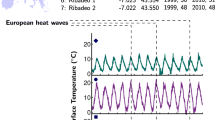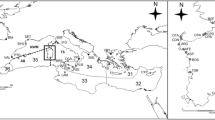Abstract
As human alterations such as riverbed excavation and harbor improvements have diminished natural littoral regions and estuarine basins, the numbers of organisms living in tidal marsh have declined. The tidal marsh halophyte Carex rugulosa has been commonly observed along the Japanese coastline over the past centuries; however, this species has recently been designated as near threatened. To determine the genetic structure of C. rugulosa, we examined the genetic composition within and among populations and attempted to clarify habitat salinity. Large populations along the Pacific Ocean exhibit relatively high clonal diversity and repeated seedling recruitment, which maintain the genotypic diversity in those populations. Conversely, lower clonal diversity is observed at the distributional margins, suggesting that marginal populations have low seedling recruitment. In terms of habitat salinity, high genetic diversities were observed between 5 and 15 psu in the Hii River watershed. The extant populations in Japan comprise three genetically distinct clusters whose population divisions correspond to the geological distribution and direction of ocean currents around Japan. Our results suggest that most C. rugulosa populations have relatively high inbreeding coefficients or low clonal diversities due to low seed recruitment or fragmentation and that reduction of genetic connectivity among populations is one causality for this low genetic diversity.





Similar content being viewed by others
References
Arnaud-Haond S, Duarte CM, Alberto F, Serrão EA (2007) Standardizing methods to address clonality in population studies. Molecular Ecology 16:5115–5139
Bockelmann AC, Reusch TBH, Bijlsma R, Bakker JP (2003) Habitat differentiation vs. isolation-by-distance: the genetic population structure of Elymus athericus in European salt marshes. Molecular Ecology 12:505–515
Doyle JJ, Doyle JL (1987) A rapid DNA isolation procedure for small quantities of fresh leaf tissue. Phytochemical Bulletin 19:11–15
Eckert CG (2001) The loss of sex in clonal plants. Evolutionary Ecology 15:501–520
Ehlers A, Worm B, Reusch TBH (2008) Importance of genetic diversity in eelgrass Zostera marina for its resilience to global warming. Marine Ecology Progress Series 355:1–7
Eriksson O (1989) Seedling dynamics and life histories in clonal plants. Oikos 55:231–238
Evanno G, Regnaut S, Goudet J (2005) Detecting the number of clusters of individuals using the software STRUCTURE: a simulation study. Molecular Ecology 14:2611–2620
Falush D, Stephens M, Pritchard JK (2003) Inference of population structure using multilocus genotype data: Linked loci and correlated allele frequencies. Genetics 164:1567–1587
Frankham R, Ballou JD, Briscoe DA (2002) Introduction to conservation genetics. Cambridge University Press, Cambridge
Guo SW, Thompson EA (1992) Performing the exact test of Hardy-Weinberg proportion for multiple alleles. Biometrics 48:361–372
Honjo M, Kitamoto N, Ueno S, Tsumura Y, Washitani I, Ohsawa R (2009) Management units of the endangered herb Primula sieboldii based on microsatellite variation among and within populations throughout Japan. Conservation Genetics 10:257–267
Jakobsson M, Rosenberg NA (2007) CLUMPP: a cluster matching and permutation program for dealing with label switching and multimodality in analysis of population structure. Bioinformatics 23:1801–1806
Kalinowski ST, Taper ML, Marshall TC (2007) Revising how the computer program CERVUS accommodates genotyping error increases success in paternity assignment. Molecular Ecology 16:1099–1106
Katsuyama T (2005) Carex of Japan (in Japanese). Bun–itchi-Sougou Publication, Tokyo
Keller BEM (2000) Genetic variation among and within populations of Phragmites australis in the Charles River watershed. Aquatic Botany 66:195–208
Kondo T, Nakagoshi N, Isagi Y (2009) Shaping of genetic structure along Pleistocene and modern river systems in the hydrochorous riparian Azalea, Rhododendron ripense (Ericaceae). American Journal of Botany 96:1532–1543
Kunii H (2001) Distribution of endangered aquatic macrophytes in lakes Shinji and Nakaumi (in Japanese with English abstract). Laguna 8:95–100
Kunii H, Imada N (2008) Conservation ecology of endangered halophyte, Carex rugulosa Kükenth, growing in Ohashi River, Shimane Prefecture (in Japanese with English abstract). Nature Restoration and Conservation Society Japan 4:7–14
Laegdsgaard P, Kelleway J, Williams RJ, Harty C (2009)Protection and management of coastal saltmarsh (chapter 9). In: Saintilan N (ed) Australian saltmarsh ecology. CSIRO Publishing, pp.179–210
Liao LC, Hsiao JY (1998) Relationship between population genetic structure and riparian habitat as revealed by RAPD analysis of the rheophyte Acorus gramineus Soland. (Araceae) in Taiwan. Molecular Ecology 7:1275–1281
Mantel N (1967) Detection of disease clustering and a generalized regression approach. Cancer Research 27:209–220
Ministry of Construction (1961) Report on the survey of the abnormal tidal waves tsunami caused by the Chilian earthquakes on May 24 1960 (in Japanese). Geographical Survey Institute
Ministry of the Environment (2000a) Threatened wildlife in Japan, red data book (in Japanese). Government of Japan
Ministry of the Environment (2000b) Biodiversity information system, Government of Japan, http://www.biodic.go.jp/rdb/rdb_top.html (in Japanese)
Ministry of the Environment (2001) The result of the selection of important wetlands in Japan–500 important wetlands in Japan. Nature Conservation Bureau, Policy and Coordination Division Government of Japan http://www.sizenken.biodic.go.jp/pc/wet_en (in Japanese)
Ministry of the Environment (2008) Threatened wildlife in Japan, revised Red Data list (in Japanese). Government of Japan
Nei M (1987) Molecular evolutionary genetics. Columbia University Press, New York
Ohbayashi K, Hodoki Y, Nakayama S, Shimada M, Kunii H (2008) Development of new microsatellite markers from a salt-marsh sedge Carex rugulosa by compound simple sequence repeat-polymerase chain reaction. Molecular Ecology Resources 8:1497–1499
Ohsako T (2010) Clonal and spatial genetic structure within populations of a coastal plant, Carex kobomugi (Cyperaceae). American Journal of Botany 97:458–470
Olsen JL, Stam WT, Coyer JA, Reusch TBH, Billingham M, Bostrom C, Calvert E, Christie H, Granger S, La Lumiere R, Milchakova N, Oudot-Le Secq MP, Procaccini G, Sanjabi B, Serrao E, Veldsink J, Widdicombe S, Wyllie-Echeverria S (2004) North Atlantic phylogeography and large-scale population differentiation of the seagrass Zostera marina L. Molecular Ecology 13:1923–1941
Palop-Esteban M, Segarra-Moragues JG, Gonzalez-Candelas F (2007) Historical and biological determinants of genetic diversity in the highly endemic triploid sea lavender Limonium dufourii (Plumbaginaceae). Molecular Ecology 16:3814–3827
Pollux BJA, Jong MDE, Steegh A, Verbruggen E, Van Groenendael JM, Ouborg NJ (2007) Reproductive strategy, clonal structure and genetic diversity in populations of the aquatic macrophyte Sparganium emersum in river systems. Molecular Ecology 16:313–325
Pritchard JK, Stephens M, Donnelly P (2000) Inference of population structure using multilocus genotype data. Genetics 155:945–959
Procaccini G, Olsen JL, Reusch TBH (2007) Contribution of genetics and genomics to seagrass biology and conservation. Journal of Experimental Marine Biology and Ecology 350:234–259
Raymond M, Rousset F (1995a) An exact test for population differentiation. Evolution 49:1280–1283
Raymond M, Rousset F (1995b) GENEPOP (VERSION-1.2)–population-genetics software for exact tests and ecumenicism. Journal of Heredity 86:248–249
Reusch TBH (2001) Fitness-consequences of geitonogamous selfing in a clonal marine angiosperm (Zostera marina). Journal of Evolutionary Biology 14:129–138
Reusch TBH (2002) Microsatellites reveal high population connectivity in eelgrass (Zostera marina) in two contrasting coastal areas. Limnology and Oceanography 47:78–85
Reusch TBH, Stam WT, Olsen JL (2000) A microsatellite-based estimation of clonal diversity and population subdivision in Zostera marina, a marine flowering plant. Molecular Ecology 9:127–140
Rosenberg NA (2004) DISTRUCT: a program for the graphical display of population structure. Molecular Ecology Notes 4:137–138
Rousset F (2008) GENEPOP’ 007: a complete re-implementation of the GENEPOP software for Windows and Linux. Molecular Ecology Resources 8:103–106
Schleuning M, Becker T, Vadillo GP, Hahn T, Matthies D, Durka W (2011) River dynamics shape clonal diversity and genetic structure of an Amazonian understorey herb. Journal of Ecology 99:373–382
Serra IA, Innocenti AM, Di Maida G, Calvo S, Migliaccio M, Zambianchi E, Pizzigalli C, Arnaud-Haond S, Duarte CM, Serrao EA, Procaccini G (2010) Genetic structure in the Mediterranean seagrass Posidonia oceanica: disentangling past vicariance events from contemporary patterns of gene flow. Molecular Ecology 19:557–568
Silvertown J (2008) The evolutionary maintenance of sexual reproduction: evidence from the ecological distribution of asexual reproduction in clonal plants. International Journal of Plant Sciences 169:157–168
Slatkin M (1995) A measure of population subdivision based on microsatellite allele frequencies. Genetics 139:457–462
Sokal RR, Rohlf FJ (1997) Biometry: the principles and practice of statistics in biological research, 3rd edn. WH Freeman and Co, New York
Tarvis SE, Hester MW (2005) A space-for-time substitution reveals the long-term decline in genotypic diversity of a widespread salt marsh plant, Spartina alterniflora, over a span of 1,500 years. Journal of Ecology 93:417–430
Tokuoka T, Sampei Y, Itasaka N, Kamei T (2001a) A new discovery on the halocline behavior at Lake Nakaumi–from 1996 observation by the echo–sounding instrument settled on lake bottom (in Japanese with English abstract). Laguna 8:57–66
Tokuoka T, Sampei Y, Ueno H, Nishimura K, Suzaki A, Matsuda S, Kubota S, Suzuki S (2001b) Long-term observation of high-saline water mass at River Oohashigawa, Shimane Pref., Japan (observation in Autumn, 1999)(in Japanese with English abstract). Laguna 8:79–90
Travis SE, Proffitt CE, Ritland K (2004) Population structure and inbreeding vary with successional stage in created Spartina alterniflora marshes. Ecological Applications 14:1189–1202
Unoki S, Kubota M (1996) Waves and currents in the Ocean (in Japanese). Tokai University Press, Japan, p 356
van Katwijk MM, Bos AR, de Jonge VN, Hanssen L, Hermus DCR, de Jong DJ (2009) Guidelines for seagrass restoration: importance of habitat selection and donor population, spreading of risks, and ecosystem engineering effects. Marine Pollution Bulletin 58:179–188
Acknowledgments
We thank the following agencies and people for providing habitat information: Nature Conservation Bureau, Policy and Coordination Division; Committee of the Japanese Society for Plant Systematics; Dr. T Yahara and Dr. T Fujita (Kyusyu Univ.); Dr. T Ohba and Ms Y Kimura (Chiba Prefecture); and Dr. S Araki (Shimane Univ.). We also thank Dr. F Ishihama (National Institute for Environmental Studies); Mr. Kamiya (Shimane Univ.) for collecting samples; and Dr. A Nakatsuka, Dr. T Nakagawa, Dr. H Ashida, and Dr. F Aranishi (Shimane Univ.) for DNA sequencing. We also thank Dr. S Pennings and three anonymous referees for improved our manuscript. This study was supported by a grant from JSPS to H. Kunii (No. 19201017).
Author information
Authors and Affiliations
Corresponding author
Electronic supplementary material
Below is the link to the electronic supplementary material.
ESM 1
(PDF 251 kb)
Rights and permissions
About this article
Cite this article
Ohbayashi, K., Hodoki, Y. & Kunii, H. Estimation of the Genetic Composition of a Near-Threatened Tidal Marsh Plant, Carex rugulosa, in Japan. Wetlands 32, 175–184 (2012). https://doi.org/10.1007/s13157-011-0266-4
Received:
Accepted:
Published:
Issue Date:
DOI: https://doi.org/10.1007/s13157-011-0266-4




